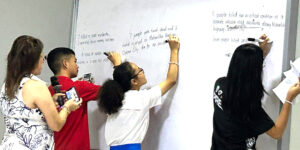
Do you easily give up when the going gets tough? Or, are you the kind who sticks around and finds ways to turn lemons to lemonade? If you are the latter, then you probably have a high adversity quotient. Adversity quotient is a person’s ability to manage difficulties and transform impediments into opportunities. According to studies, AQ is one important factor that affects an individual’s success, because it correlates positively with a person’s performance.
Hurlock (2000) pointed out that a person who has a high adversity quotient is a high-performing student or a high-performing employee because those who have poor AQ or do not have one at all, will always depend on others like their parents and peers.
I remember what a friend of mine who is the corporate marketing and communications officer of a formidable brand, shared to me. Most companies share the same concern they have about their new hires who are either Gen Z (18-25 years old according to LinkedIn) or millennials (26-41 years old according to LinkedIn): they are all quick to leave their jobs. They easily get bored, de-motivated and uninterested. No staying power.
Morgan Smith wrote at the start of the year, about Gen Z and millennials leading the big quit in the USA, with younger employees leading the wave. In his article, Smith pointed out that 4.2 million people voluntarily left their jobs in November 2022 and new research discovered that more Americans are planning to job hop soon.
Millennials have a long-standing reputation for job-hopping which is a practice that has become increasingly popular over the past two years. On the other hand, Gen Zers who started their careers in remote work and hybrid environments at the height of the pandemic on the other hand, are “experimental” as they are trying to figure out what they want out of a job, said Karin Kimbrough, LinkedIn chief economist.
Students must also have high AQ in order to perform well in school amid varying circumstances. By being able to take control of the situation, students are able to take advantage of opportunities no matter what the situation is. For instance, the onset of the pandemic required adaptability to facing problems as the circumstance led to social restrictions and difficulty in accessing educational facilities. Students could only obtain learning materials online or by other means. Students had to be adaptable. AQ affects students’ adaptability as revealed in a 2021 study by Anik Puji Rahayu.
Meanwhile, Sukardewi et al. (2013) revealed a significant effect of AQ on work ethics, school organization and culture, and teacher performance.
All these research findings only say one thing: while intelligence is an integral part of excellence, it is not, however, the only determinant of a person’s success. Success is not only determined by one’s achievements but is also dependent on how capable a person is in persevering during adversities.
Paul Stoltz, considered as the world’s leading authority on the integration and application of grit and resilience, emphasized that AQ is “one of the most important factors in achieving success” as. Stoltz identified flexibility, perseverance and the ability to face problems in duties, work and life as measurements for success. People who can solve problems more efficiently can control the situation and have a higher chance of success.
He said there are three types of people based on their AQ level: quitters, campers and climbers. According to him, quitters are those who lead compromised lives, easily broken by negative events and become hopeless about their successes. Quitters who are less ambitious, quickly surrender from every attempt to overcome barriers and refuse to solve problems. Campers on the other hand, are ready to fight to an extent but are sadly not persistent in their efforts because they choose comfort. Inconvenience scares them. That is why in an organization, they are average workers. Climbers are the real achievers. They are ready to fight until they achieve success regardless of the challenges they have to hurdle. They never give up until they reach their goal. “Nothing in life can defeat them because they are self-motivated, consistent, highly optimistic and remain hopeful amid difficulties” stressed Stoltz. Elizabeth Le Thi (2007) identified climbers as the ideal workforce as they are highly motivated and committed. They have the intention to grow and excel in life.
Since AQ is an acquired trait, Stoltz proposed a strategy to help quitters and campers transform into climbers. His LEAD sequence includes Listening to one’s response to adversity, Establishing accountability, Analyzing the evidence and Doing something.
Additionally, he formulated four dimensions to measure AQ which he calls CORE which stands for control, ownership, reach and endurance.
Control is the extent to which a person is able to manage his life and control the negative consequences before getting worse. Ownership refers to the extent to which an individual is accountable for his actions and is willing to take responsibility to turn adverse conditions to something better. Reach measures how much one is capable of preventing problems from affecting his profession or family life. Endurance is the capability of a person to bear pain and remain optimistic about the future, staying hopeful that something positive awaits one at the other end of adversity.
A related research by Shivaranjani in 2014 stressed that control is determined by resilience and tenacity. Tenacity is the quality or fact of being able to grip something firmly or the quality of being determined. Furthermore, the study also emphasized that ownership is determined by action and engagement while reach by burden and effort and endurance by hope and willingness to persevere.
Gallup 2022 data revealed that Gen Zers are the most stressed and burned out in the workplace, and this “stress is leading to ambivalence and withdrawal from their professional lives”.
Santor Nishizaki, organizational leadership expert and book author said they found out that “during the pandemic, a good portion of Gen Zers admitted to not giving their full effort at work, which is a symptom of burnout and other workplace behaviors”.
According to the same report, they are the most disengaged group at work. If the stress and burnout are not handled well, it will influence job performance and career growth or worse, drive them to quit.
With experiences in the military, teaching Master in Business Administration students abroad, business leader and executive coach Jan Rutherford observed that the most effective and authentic leaders all do these simple things really well: solitude, pace and adversity.
Rutherford explained effective and genuine leaders have the self-discipline to pause and reflect, have a sense of purpose and heroic aspirations beyond power and money. They truly want to make a difference in the lives of others.
The second trait is pace or the speed at which the team is stretched, not broken. “No team is capable of going ninety miles per hour every day. Just like ascending the mountain, the leader has to read the team to hear pains unexpressed, fears undisclosed and complaints not spoken. The leader has to sense when to step on the gas, when to ease up and when to take a break. When it comes to endurance, sometimes you have to slow down to speed up,” he explained.
Finally, the quotient for adversity is what leaders must have. A high-performing leader is willing to take risks, willing to attempt at something, and not succeed because it only means failure if no lesson was learned according to Rutherford.
For a real hero goes the distance with grace and temerity, no matter how many times he stumbles and keeps going, and still has plenty to give.
Here’s my favorite excerpt from Rutherford’s talk on “Courage, Honor and Stoicism”, “Creating your own crucible means facing the real possibility of failure, but the product of adversity is pressurized grace.”*







